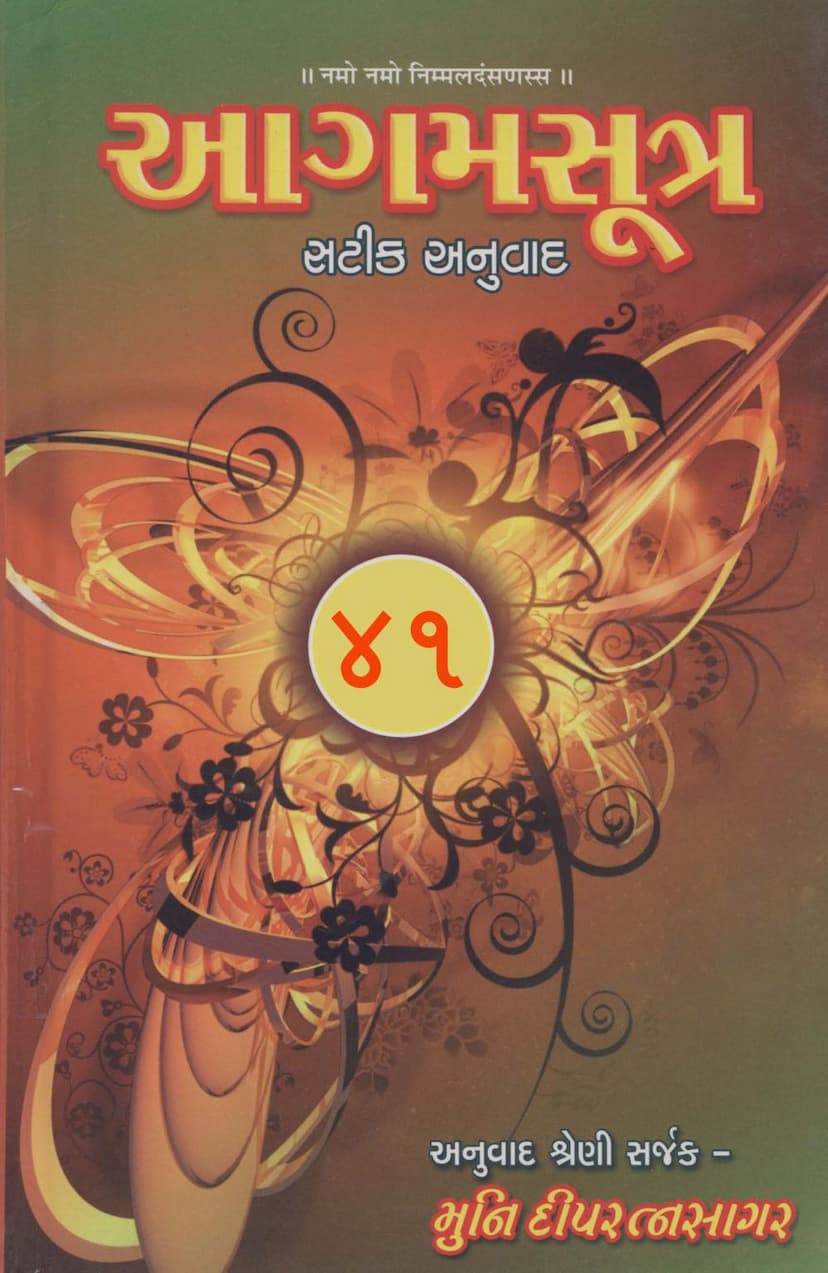Agam 45 Anuyogadwar Sutra Satik Gujarati Anuvad
Added to library: September 1, 2025

Summary
Summary of Agam Sutra Satik Gujarati Anuvad, Book 41: Anuyogadwar Sutra (Translated and Commented Gujarati)
This volume, book 41 of the Agam Sutra Satik Gujarati Anuvad series, presents the Anuyogadwar Sutra, also known as "Anuyogdwar" in Prakrit and "Anuyogdwar" or "Anuyogadvar" in Sanskrit. The text introduces this sutra as a "key sutra" within the Agam literature because its principles of "Anugam, Nikshep, Nay" are fundamental to the commentary of other Agams.
Key Features of this Edition:
-
Focus on "Sānuvād Vivechan" (Commentary with Translation): Unlike previous volumes in the series which offered a "Satic Anuvad" (translation with commentary), this edition adopts a "Sānuvād Vivechan" approach for Anuyogadwar Sutra. This means it provides a translation and commentary that serves as an "entrance" or "gateway" to understanding the profound concepts within this particular sutra. The commentary aims to be easily understandable for beginners, while acknowledging that deeper insights can be found in texts like the Vritti by Malladhari Hemchandrasuri.
-
Comprehensive Coverage: The Anuyogadwar Sutra is presented with its Gujarati translation and detailed commentary, covering a wide range of philosophical and methodological concepts within Jainism.
Content Overview of the Anuyogadwar Sutra as presented in this volume:
The Anuyogadwar Sutra, according to the commentary, primarily deals with the concept of "Anuyog" (analysis or explanation). However, it also encompasses various crucial subjects such as:
- Aavashyak (Obligatory duties): Their names, nature, and various classifications.
- Shrut (Scriptural knowledge): Its categories, synonyms, and the process of its study (Uddesh, Samudesh, Anugam, Nay).
- Skandh (Division/Section): The concept of divisions within scriptural knowledge.
- Upakram (Introduction/Beginning): The initial steps and methods for approaching a subject.
- Anu-purvi (Sequential order): The importance of sequential arrangement in knowledge.
- Nay (Standpoints/Approaches): Various perspectives for understanding reality.
- Praman (Means of valid knowledge): The methods for acquiring correct knowledge.
- Samavtar (Classification/Confluence): How things are categorized and brought together.
- Nikshep (Placement/Categorization): Different ways of placing or categorizing concepts.
- Anugam (Sequential analysis): The step-by-step process of understanding.
- Tattvas (Principles): Fundamental truths and principles of Jainism.
Specific Topics Covered in the Commentary (based on the provided text):
The detailed text outlines the Anuyogadwar Sutra's structure and the commentary's approach to each section. It begins with the mangala-sloka mentioning the five types of knowledge (Jnan). The commentary then delves into the etymology and various classifications of 'Jnan'.
The text further elaborates on the distinctions between different types of knowledge, particularly highlighting Shrut-jnana (scriptural knowledge) as the only knowledge that can be directly taught and studied. It then meticulously explains the concept of Nayas (standpoints), discussing the views of various Nayas (like Naigamanay, Sangrahanay, Vyavaharanay, etc.) on concepts like 'Aavashyak' and 'Skandh'.
The commentary also provides extensive details on:
- Namas and Sthanas: The different ways names are assigned and established for concepts.
- Dravya (Substance) and its types: Dravyapariman (quantitative aspects of substances) are discussed in detail, distinguishing between 'Aagam dravya' and 'Nao-aagam dravya'.
- Kala (Time): The measurement and classification of time, including Kalas, Aavlikas, Muhurtas, Yojanas, and cosmological time units like Palyopam and Sagaropam.
- Sharir (Bodies): The classification of bodies (Audarik, Vaikriya, Aaharak, Taijas, Kaarman) and their existence in different souls.
- Narak Avagahana: The dimensions and lifespans of beings in the various Naraka (hell) realms.
- Tiryak Pind: The lifespans and dimensions of various categories of beings in the animal and plant kingdoms (Tiryanchan Gati).
- Manushya Avagahana and Ayush: The dimensions and lifespans of human beings.
- Deva Ayush: The lifespans of various classes of celestial beings (Bhavanapati, Vyantaras, Jyotishkas, and Vaimanikas).
- Nirvasana (Destiny/Merit): The concept of destiny and its impact on beings.
- Linga (Gender): The classification of names based on gender.
- Various types of Names: Explaining names based on qualities, actions, connections, traditions, and conventions.
- Praman (Means of Knowledge): Elaborating on different types of knowledge acquisition like Pratyaksh, Anuman, Upama, and Aagam.
- Rasa (Emotions/Aesthetics): Describing the nine Rasas (emotions) and their manifestations.
- Sankhya (Numerals): Discussing the concepts of Sankhyat (countable), Asankhyat (uncountable), and Anant (infinite) with their various sub-categories.
Purpose and Significance:
This volume aims to provide a thorough understanding of the Anuyogadwar Sutra, a foundational text in Jain philosophy. By offering a detailed translation and commentary, it enables readers to grasp complex concepts related to knowledge, reality, time, existence, and the methods of scriptural analysis within the Jain tradition. The accessibility of the commentary makes it a valuable resource for both scholars and those new to the study of Jain Agamas.